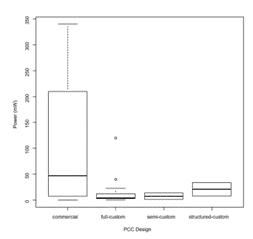Introducción
Technological advancements regarding feature size reduction in CMOS technologies and MEMS newfound integration capabilities, have allowed the use of Implantable Medical Devices (IMD) in a wide range of applications. Commercial implantable devices have been successfully applied in fields such as deep-brain stimulation, hearing aid, and the well-known pacemaker. However, research efforts in the IMD realm reach beyond these applications. Different research groups have presented systems that provide functions such as drug delivery, closed-loop stimulation, and optical stimulation to correct visual ailments. Furthermore, it has been observed that trends in IMD design have been gradually shifting from rigid application-specific designs to flexible general-purpose systems (1), (2). With the aim to understand the evolution of IMDs in the context of electronics systems, a survey of academic journal publications was made. Based on the work presented in (3), this survey of the relevant scientific articles covers a period from 1974 to 2018. Traditionally, state of the art reviews and investigations of biomedical implants have covered limited sets of systems and cases of study, restricted to specific applications or sub-system modules common to a group of devices, for example; Point of Care (POC) monitoring systems are surveyed and reviewed in (4), where the maturity of some selected works and their suitability to become a commercial alternative in the healthcare market are evaluated. Other applications, as glucose monitoring and neuro-stimulation, have been the subject of the surveys presented in (5)-(7). Three different glucose monitoring implantable systems are discussed in (5), putting emphasis on technical features, advantages and disadvantages of the proposals, identifying several unresolved challenges. Neuromodulation systems are surveyed with different approaches in (6), (7). Acknowledging the various strategies to increase channel count in neuro-stimulation systems, (6) presents a survey of scalable multi-chip systems, where a network of devices works in concert to achieve multi-site neural interaction and stimulation and gives an example of such a system. On the other hand, (7) presents a survey of commercial neuro-stimulators, classified in two different groups: open-loop and closed-loop neuro-stimulators. As the importance of communication features grows on modern IMDs, telemetry sub-systems become the subject of several studies. Alternatives include wired, optical, infrared, or RF communication schemes. A review of capacitive datalinks is presented in (8), including different methods, applications, tools, and materials involved in the manufacturing process. Since wireless communication has become the norm in most modern implantable systems, a significant effort has been devoted on the enhancement of security measures against malicious attacks. Several surveys have collected these efforts with different approaches (9)- (12). In (9), a review of security issues arising from the use of body area networks in healthcare is performed, covering threats such as eavesdropping, impersonation, and jamming, in addition to a survey of different techniques used against these attacks and their evaluation. Both (10) and (13) extend the scope of this effort. The survey presented in (10) adds different kinds of attacks to the review and different scenarios and modes of operation under which the IMD normal operation can be compromised, whereas (13) finds a gap in the attention placed in software and sensor interface layer exploitation when compared to the security of the telemetry interface. Finally, (12) presents a survey of several security techniques from the perspective of access control schemes, with a classification based on architecture, logic, keys used, and other characteristics.
This work moves away from the previous approaches and presents a tool for an integral survey of the electronics in IMD systems. A database with over 200 articles reporting complete IMD solutions in the academic domain up to 2018 has ben consolidated and is currently being analyzed. IMD features are considered for different categories that represent the levels of abstraction of the design space. High-level considerations such as biomedical application and functionality are included, as well as low-level features regarding implementation, electromechanical aspects, and performance of the system.
Survey scope and methodology
To obtain a structured dataset on which statistical operations can be performed with relevant results, the scope and organization of the survey must be defined. To consider an implantable system in the survey included in the data base, it must comply with two distinct requirements. First, only stand-alone systems, defined as units that provide complete functionality, are studied. Second, only microelectronic- and MEMS-based IMDs are considered. The first restriction leaves out of the study a series of published works that report sub-system modules, such as analog front-ends, sensors, or read-out circuitry. The second consideration excludes the analysis of mechanical implants such as artificial limbs and biomedical systems that are not intended for in vivo operation. The structure, features and approach of the data used in this section corresponds to a taxonomy defined in (1) and (2). This taxonomy encompasses a series of attributes of microelectronic-based IMDs, organized under 8 different categories. This series of attributes cover the main characteristics of such systems, putting a special emphasis on the Processing or Controlling Core (PCC). The 8 categories are defined as follows.
Functionality: refers to the nature of the functions performed by the implant. These range from generic functions such as stimulation and measurement to more specialized ones, for example drug delivery.
Application: points to the medical condition that the system is intended to manage.
Electromechanical features: gathers several attributes that describe the system design strategy and implementation from a mechanical and packaging perspectives, such as the number of ICs, total area of the chipset and total volume of the package.
Power features: consider aspects of the system such as power source, operating voltage, and low-power operation techniques included in the design.
General features: presents some high-level characteristics of the design that consider the kind of processing performed by the PCC, the capability to store data, and the stimulation methods, if present.
PCC features: details the design of the PCC with the consideration of several aspects specific to this unit. This category considers characteristics such as the number of instructions and frequency of operation of the core, the PCC architecture, and the size of the instructions and data-words.
Miscellaneous features: present some design aspects in a binary fashion, detailing if such attributes are implemented or not. These attributes are programmability, versatility, modularity, adjustability, reliability, and security
Communication features: considers design aspects related to data and command transfer between the implantable system and external units. Some aspects classified under this category are modulation and encoding schemes, transmission rates, packet size, and multipoint communication support.
Considering the previously described restrictions and taxonomy, a database of standalone systems is constructed. Each entry of the database corresponds to a system described in the literature. A total of 220 systems are considered so far, as previously mentioned, spanning a period from 1974 to 2018. The database used for the analysis in this paper is extensible and open for the scientific community.
From each one of the categories and sub-categories presented in the data base to characterize each one of the publications, a statistical variable can be extracted to perform different kinds of analysis. Although almost every taxonomy parameter can be treated as a statistical variable, some of them are split into more than one variable to extract meaningful results, for example, power consumption, which is divided into: average consumption, peak active consumption and standby consumption. Depending on the nature of the variables they are defined as categorical or scale variables. Examples of categorical variables are functionality, PCC architecture and low-power provisions. Scale variables range from operating frequency and operating voltage to power consumption and ADC resolution. Here, using the above definitions, several research questions can be answered with the use of different statistical tools applied to the data base. These research questions seek to analyze the relations between variables, and to foreground trends in the data. To present the results in an intelligible fashion, accompanied by a precise analysis, the research questions here are answered using five different types of statistical tests. One crucial aspect to understand is the relation and impact of a categorical variable over another of this same nature. This implies the need to test if two different categorical variables are independent of each other. A proper statistical tool to evaluate this hypothesis is the chi-square (χ2) test, which is accompanied by correspondence analysis (CA) plots to identify the relations between the two variables qualitatively. It is also of interest to test if categorical variables show changes over time, which represents the second set of research questions. It seems convenient to use the same statistical tools (i.e., chi-square tests and CA plots) to explore the correlation between such variables. However, this poses a problem in the sense that the publication year is a scale variable. To avoid this inconvenience, publication years are grouped into different periods to obtain equivalent categorical variables and perform the tests. The third set of statistical questions is proposed to explore the relations and changes of scale variables over time. For scale variables, the proper tool is simple regression analysis. Linear and polynomial regression lines are fitted through least-squares (LS), least-median-of-squares (LMS), and least-trimmed-square (LTS) estimations. The fourth subset of research questions is introduced to test whether a categorical variable affects the evolution of a scale variable over time. Scatterplots are used to show the distribution of the scale variable separately for different categories. A Log-Likelihood ratio (G) test is also provided, to determine if the different categories merit separate handling. Finally, it is desirable to compare a scale variable over groups, meaning over the different classes of a categorical variable. This constitutes the fifth subset of research questions and statistical tests. Kruskal-Wallis rank sums tests and boxplots are used to evaluate the scale variable across the groups of the categorical variable. The next section shows a selection of some of the outputs that can be obtained using the data-base. This analysis is not intended to be complete and many questions are left open; the intention here is to provide a taste of the information that may be obtained using the tool and the approaches that can be used.
Tool Implementation
In order to enable an easy access to the database we developed a friendly SQL interface accessible through a web page: http://imdsurvey.ietec.org. A brief description of the project and instructions on how to access both, the open SQL interface to query the data base and the SQL interface with edition privileges is provided in the welcome page.
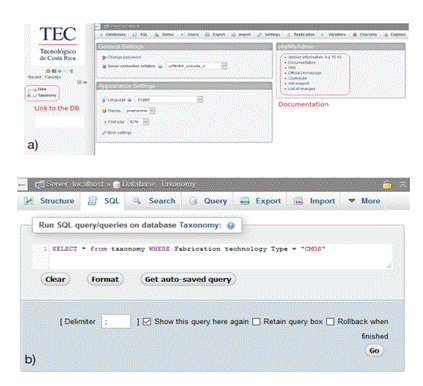
Figure 1 Graphical Interface of the IMD public database: (a) front page of the SQL platform, (b) SQL interface for queries.
In figure 1, an illustration of the initial interface of the tool is presented; once you enter in the platform, you can potentially access different versions of the database, however, at this point only the seed database called “Taxonomy” is accessible. In this initial interface you will be also able to access documentation about the capabilities of each one of the tools available in the platform.
After clicking the Taxonomy database, you can select the SQL tab, to start querying the database. An interface like the one shown in Fig. 1(b) will be used to enter any SQL query. To execute the query just click on the “Go” button. The results of the query will be printed in a friendly way and at the bottom of the screen you will be able to find more capabilities like for instance the capacity to create a charts, printing the results, or export them in several formats such as CSV, JSON, XML, PDF between many options.
Preliminary Results and Analysis
In figure 2, publications are grouped in 5-year groups, be-ginning from 1989, since from this year forward, publications are found for every consecutive year. Before 1989, entries are found only for some isolated years. The idea behind this grouping is to determine whether there exists a growing trend in the number of publications over time, considering that research cycles (comprising the process that culminates in the publication of the results) usually take longer than a year. Effectively, figure 2 confirms such trend. The fact that figure 2 shows sustained growth in IMD research over the years confirms its importance for the scientific community. The following results are arranged according to the statistical tests proposed in section III-A. Numerical values for the respective tests are collected in tables, while visual explorations are represented in the respective figures.
Independence of two categorical values
As an example of the analysis of independence of two categorical variables, figure 3 shows the CA plot for the categorical variables “functionality” and “PCC design”. In addition to these results, a χ2 analysis is performed to determine if the two categorical variables are independent of each other. The results from the χ2 tests performed over couples of categorical variables are reported in TABLE 1. The results of a χ2 test are evaluated in the standard way with regards of the resulting p-value; if p > 0.05, it is said that the null hypothesis cannot be rejected, whereas if the opposite condition is satisfied (p < 0.05), the null hypothesis is rejected. In table 1 the results of the χ2 tests applied to couples of categorical variables are presented. For the variables “functionality” and “PCC design”, the χ2 test produces a p-value of p= 0.15266.
This value indicates that it is not possible to reject the null hypothesis of both variables being independent of each other, this behavior may be explained in part because of the heterogeneity of the applications in the IMD domain as well as for the lack of standardization in this field.
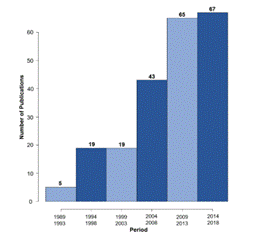
Figure 2 Number of scientific papers about IMDs per period of publication. Published articles are grouped in 5-year periods.
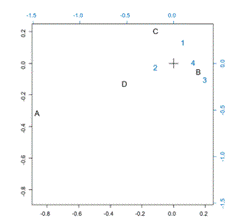
Figure 3 CA plot for the categorical variables Functionality (letters) and PCC Design (numbers). The labels for Functionality are assigned as follows: (A) generic function, (B) measurement, (C) stimulation and (D) stimulation/ measurement. For PCC Design the labels are: (1) commercial, (2) full-custom, (3) no PCC, (4) semi-custom.
Even so, from figure 3, it is possible to find trends in the data. It is evident that systems designed to perform only monitoring tasks (measurement) are inclined to use semi-custom PCCs or no PCC at all. This tendency is probably because, in most of these devices, the data processing is implemented externally, by directly reading the data in the internal memory of the device or by using wireless communication interfaces. There is also a proximity between commercial PCCs and therapeutic functionalities (stimulation). This tendency implies that the complexity of such functions implies the use necessity of heavier processing than the one that could be accomplished by a small custom PCC, and it is easier to buy a commercial solution than to develop a custom PCC capable of performing the task.
Finally, it is apparent that full custom PCC designs are more suitable for systems that implement both functionalities. This may imply that in these cases, commercial PCCs are not well suited for the task, and the teams can´t avoid the development of custom or semi-custom solutions. Given this situation, it appears that a generic micro-controller that facilitate the customization of features, interfaces, memory, and instructions may be a good fit for the development of different functionalities common in the IMD domain.
Evolution of categorical variables over time
The results from the χ2 analysis performed to categorical variables over periods are shown in table 2. The χ2 tests how there is a correlation between the “time periods” and the “internal processing”. It is interesting to notice in this figure that before 2004 most of the systems reported no complex processing; in the period from 2004-2008 the trend was towards control, and the trend has been moving towards data processing in recent research. It must be considered that this is a general trend noticed in any particular application. This trend may be related to the development of mobile powerful processing devices capable of communicating and processing the data gathered by the implantable devices outside the body. In the case of the categorical variables “adjustability” and “low-power provisions”, the χ2 results does not show inherent correlation to the year of publication for the systems.
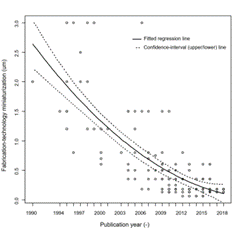
Figure 4 Scatter plot for the scale variable “Fabrication technology” against year of publication A regression line (solid) is added to the plot, accompanied by the confidence intervals (dotted).
Change of “scale variables” over time
In addition to the scattering plots, quadratic regression lines may also be computed and evaluated. In the case of figure 4, it is noted that fabrication technology sizes downscale as the year of publication increases. This tendency agrees with the general semiconductor industry trends. It supports the fact that integration levels are higher as more advanced technology is used, increasing system capabilities and allowing for the implementation of more functionalities in a single device.
Something interesting to notice in figure 4 is that even when there is an improvement in the technology node for the fabrication of IMDs, this node is always behind the top fabrication node available. For example, in the latest work published in 2018, the nodes used are in the order of 180-130nm, while the top node in the industry is in the order of 10nm. This trend may be explained because of the reliability required in medical systems. Here, the latest technologies, even when they support lower power voltages and higher integration, are not as mature as older nodes where there is better control over the fabrication process and are less prone to failures.
Relation of scale variables over groups
The last subset of tests refers to the analysis of scale variables for different categorical classifications. For this analysis, boxplots can be used. Examples of scale variables which may be evaluated are power consumption and total chipset area. For these tests, numerical results can be found in table 3, showing that for all the evaluated cases, there is a statistically significant difference between the groups so that the independent analysis makes sense. Figure 5 shows the relation between the power consumption of the core and the strategy followed for its implementation. It can be readily noticed that commercial cores present the highest power consumption. The distribution for this class presents the highest mean and the highest maximum for all the classes considered in this figure. Since commercial solutions target general applications, their specifications are not specifically tailored for the system. This fact makes fullcustom alternatives a more attractive solution to achieve the requirements imposed for IMDs. Figure 5 supports this claim, as evidenced by the fact that, among all the alternatives, full-custom PCCs show the lowest power consumption. However, it is useful to notice that semi-custom and structured-custom solutions present a power consumption close to the full custom cores. In cases in which design time and efforts must be reduced, semi-custom and structured-custom cores also constitute suitable design alternatives.
Conclusions
In this paper, we presented an extensible approach intended to easy the exploration of the trends for the IMD field, based on a survey of the relevant scientific articles published in this area in a period from 1974 to 2018, including more than 200 publications. The increasing interest of the scientific community in this subject is evident from the number of published articles in time. Even though there are many systems implemented using commercial IP for its PCC, it is essential to notice here that the custom and semi-custom implementations are the ones with better results in terms of power consumption and area of implementation, which are central features in this field.
Even when the technological node of the systems has been improving in time, is interesting to notice that the trend is always way behind the top node of the industry so for example in 2018 most systems are implemented using 180nm-130nm technologies while the latest industry node is in the order of the 10nm. This trend may be explained by the reliability requirements of medical systems, which imply the use of mature, well-characterized, and controlled technologies.
The lack of standards in the development of IMDs is evident due to the variety of solutions and characteristics. This lack of standardization is an opportunity for the development of tools and methodologies for the standardization of solutions for this field.
The extensible SQL data-base and structured approach are open to the scientific community; and is intended to grow and enable even more complete high-level analysis. Future work will address the extension and formal statistical analysis of the database.
This is work in progress and it is accessible at: http://imdsurvey.ietec.org

















